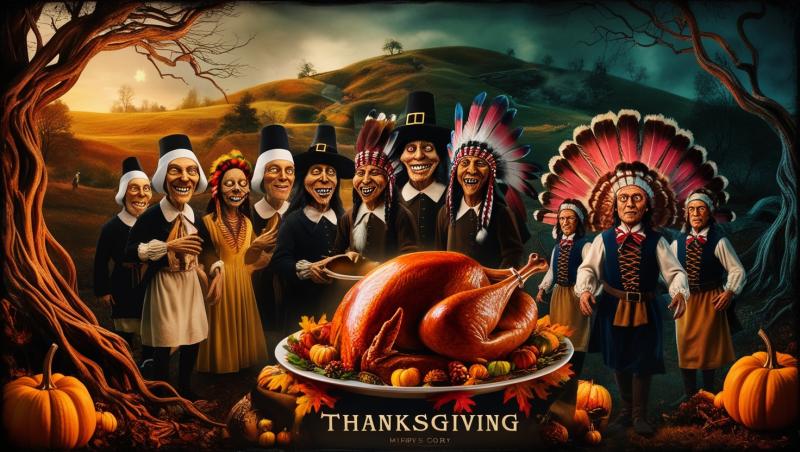What is the Traditional Story of Thanksgiving?

Thanksgiving has become a cherished holiday in North America, marked by gratitude, family gatherings, and hearty feasts. But what’s the origin story? Here, we explore the traditional tale of Thanksgiving, uncovering the history, myths, and key figures involved in its creation.
The Traditional Story of Thanksgiving
Thanksgiving’s traditional tale dates back to the early 17th century, focusing on the Pilgrims’ settlement and their first feast with the Wampanoag people. Let’s delve into the history that shaped this iconic American holiday.
The Setting: Plymouth Colony
In 1620, a group of 102 settlers, known as the Pilgrims, set sail from England on the Mayflower. They were seeking religious freedom and a fresh start in a new land. After a challenging journey, they landed on the shores of what is now Massachusetts, eventually founding Plymouth Colony.
The Arrival of the Pilgrims
The Pilgrims’ arrival was far from smooth. Their first winter was brutal, with many settlers succumbing to cold, starvation, and disease. But despite the hardships, they remained determined to establish a new life.
Life in the New World
Surviving in the New World was far more challenging than the Pilgrims had anticipated. Without the resources they were accustomed to, they struggled with basic necessities, like shelter and food. Their survival depended heavily on their ability to adapt.
The Wampanoag Tribe
The Wampanoag people were a Native American tribe who had lived in the region for thousands of years. They played a crucial role in the Pilgrims' survival and are essential to the Thanksgiving story.
Who Were the Wampanoag?
The Wampanoag were a group of indigenous people skilled in farming, hunting, and fishing. They lived in harmony with the land and had their own rich culture and traditions.
Initial Contact with Pilgrims
Although initial interactions between Native Americans and European settlers were often fraught with tension, the Wampanoag and Pilgrims eventually formed an alliance. This relationship became pivotal in helping the Pilgrims survive their first year.
Challenges of the First Winter
The first winter was devastating. With food supplies low and their community weakened by illness, the Pilgrims faced overwhelming odds.
Scarcity of Food and Resources
Food was scarce, and the Pilgrims lacked knowledge of local farming practices. Many struggled just to stay warm and nourished.
Help from the Wampanoag
It was the Wampanoag, particularly a member named Squanto, who taught the Pilgrims essential survival skills, like planting corn and fishing. This assistance was a turning point for the struggling colony.
The First Thanksgiving Feast
In the fall of 1621, after a successful harvest, the Pilgrims organized a feast to celebrate. They invited the Wampanoag, who joined them for a three-day celebration. This event is now widely considered the "First Thanksgiving."
A Gathering of Cultures
The feast was a symbolic moment of peace and cooperation between two very different cultures. It was not just a celebration of food but a moment of gratitude for survival and mutual aid.
What Was on the Menu?
While modern Thanksgiving tables are filled with turkey, mashed potatoes, and cranberry sauce, the 1621 menu was different. The feast likely included wild fowl, venison, corn, squash, beans, and seafood.
The Legacy of Thanksgiving
The story of Thanksgiving grew in significance over the years, eventually becoming a national holiday. It evolved from a story of survival to a celebration of gratitude and unity.
How the Story Became a Tradition
Thanksgiving was celebrated in various forms throughout the colonies and early states, but it wasn’t until 1863 that President Abraham Lincoln declared it a national holiday, uniting the country in a shared day of thanks.
Evolution of Thanksgiving in the United States
Today, Thanksgiving is one of the most celebrated holidays in the U.S., marked by family gatherings, parades, and traditional dishes. For many, Thanksgiving gift packaging boxes are part of the festivities, used to wrap treats and thoughtful presents, adding a layer of charm to the holiday. While the history is complex, the holiday remains a time for reflection and gratitude.
Conclusion
Thanksgiving’s traditional story is one of resilience, cooperation, and gratitude. It reminds us of the importance of coming together, even in challenging times, and appreciating the support of those around us.
FAQs
Q1: Why is Thanksgiving celebrated in November?
Thanksgiving is celebrated in November as a fall harvest celebration. President Lincoln established it as a November holiday in 1863.
Q2: Was turkey really part of the first Thanksgiving?
Probably not! Historians believe that wild fowl like ducks or geese were served instead, along with venison.
Q3: Did the Pilgrims and Wampanoag celebrate Thanksgiving every year?
No, the first Thanksgiving was a single event and wasn’t repeated annually by the Pilgrims. The idea of an annual holiday developed much later.
Q4: Who was Squanto, and what was his role?
Squanto was a Native American who helped the Pilgrims by teaching them essential survival skills, including planting crops.
Q5: How did Thanksgiving become a national holiday?
Thanksgiving became a national holiday in 1863 when President Lincoln proclaimed it during the Civil War, aiming to foster unity in the nation.

Comments